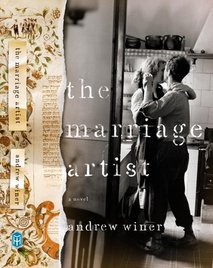
27 Oct 2010 02:14:11
Lichtmann initially believes he might have been responsible for the affair, having taken his wife to a private preview of what would turn out to be Benjamin Wind's last show. He is stunned when he finds a photograph that makes it clear the affair had started years earlier. He begins delving into the artist's past, uncovering a string of family secrets.
Lichtmann's search eventually leads him back two generations to Wind's grandfather, a brilliant artist who made a living painting Jewish marriage contracts in Vienna before World War II.
Winer skillfully weaves the two men's stories together so that it becomes clear that what initially appears to be two distinctly separate plots is one tale told over more than six decades. Lichtmann's story becomes the epilogue to the romance between Wind's grandparents in a great demonstration of Winer's skill in structuring a story.
The idea of exploring how the acts of one generation affect those who come later isn't new or unique, but Winer expands on it, considering whether perspective and personality also might be passed on, perhaps even to those who never met their forebears.
Implicit in Winer's story is the idea that Wind inherited not only his grandfather's talent, but also his struggle to balance love and the intimacy it involves with a sense of disenchantment and the need to distance himself from the ugliness often seen in the modern world. Winer creates complex characters by sketching compelling portraits but leaving space for the reader to fill in shades of gray with his or her own interpretation.
The result is a story that is engrossing and haunting. It raises questions about whether it's possible to truly love someone you know well or whether in becoming close to them, you destroy the mystery that once surrounded them.
Winer takes an unflinching look at the pain that lovers can inflict on each other and yet still leaves the reader with the sense that it is better to love and hurt than to be alone. The isolation of love unreturned, as embodied in one of the novel's main characters, is perhaps the saddest thing.
With multiple characters wrestling with their Jewish identity and the backdrop of the Holocaust, "The Marriage Artist" also takes a thought-provoking look at faith and the way people understand and experience God. In Wind's grandmother, Winer joins his themes of love and faith, as her character tries to lose her self-identity in marriage to become closer to the God in everyone.
With such complex themes and sharp scenes of human misery, "The Marriage Artist" isn't a work that can be described as enjoyable or pleasant. But that's precisely why it is important: It makes you think about those things that you might prefer to avoid and examine your own beliefs about how possible it is to be both an individual and joined in love.
Lichtmann's search eventually leads him back two generations to Wind's grandfather, a brilliant artist who made a living painting Jewish marriage contracts in Vienna before World War II.
Winer skillfully weaves the two men's stories together so that it becomes clear that what initially appears to be two distinctly separate plots is one tale told over more than six decades. Lichtmann's story becomes the epilogue to the romance between Wind's grandparents in a great demonstration of Winer's skill in structuring a story.
The idea of exploring how the acts of one generation affect those who come later isn't new or unique, but Winer expands on it, considering whether perspective and personality also might be passed on, perhaps even to those who never met their forebears.
Implicit in Winer's story is the idea that Wind inherited not only his grandfather's talent, but also his struggle to balance love and the intimacy it involves with a sense of disenchantment and the need to distance himself from the ugliness often seen in the modern world. Winer creates complex characters by sketching compelling portraits but leaving space for the reader to fill in shades of gray with his or her own interpretation.
The result is a story that is engrossing and haunting. It raises questions about whether it's possible to truly love someone you know well or whether in becoming close to them, you destroy the mystery that once surrounded them.
Winer takes an unflinching look at the pain that lovers can inflict on each other and yet still leaves the reader with the sense that it is better to love and hurt than to be alone. The isolation of love unreturned, as embodied in one of the novel's main characters, is perhaps the saddest thing.
With multiple characters wrestling with their Jewish identity and the backdrop of the Holocaust, "The Marriage Artist" also takes a thought-provoking look at faith and the way people understand and experience God. In Wind's grandmother, Winer joins his themes of love and faith, as her character tries to lose her self-identity in marriage to become closer to the God in everyone.
With such complex themes and sharp scenes of human misery, "The Marriage Artist" isn't a work that can be described as enjoyable or pleasant. But that's precisely why it is important: It makes you think about those things that you might prefer to avoid and examine your own beliefs about how possible it is to be both an individual and joined in love.

